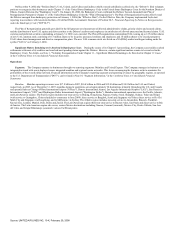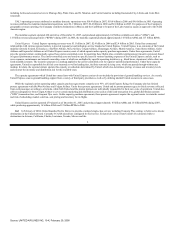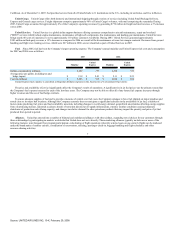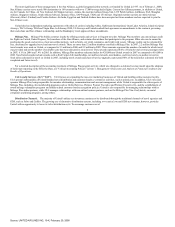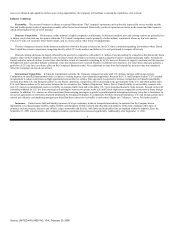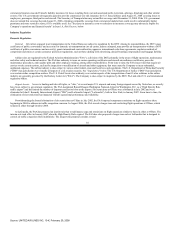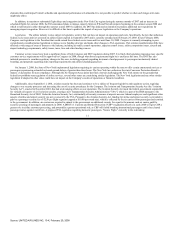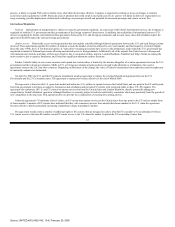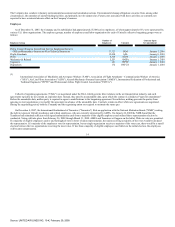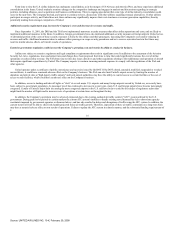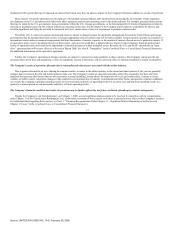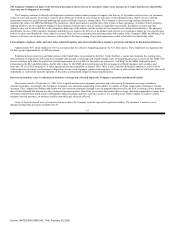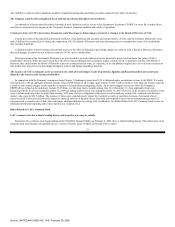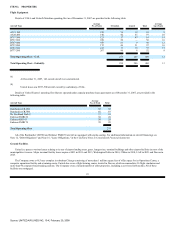United Airlines 2007 Annual Report Download - page 16
Download and view the complete annual report
Please find page 16 of the 2007 United Airlines annual report below. You can navigate through the pages in the report by either clicking on the pages listed below, or by using the keyword search tool below to find specific information within the annual report.
ITEM 1A. RISK FACTORS.
The following risk factors should be read carefully when evaluating the Company's business and the forward-looking statements contained in this report
and other statements the Company or its representatives make from time to time. Any of the following risks could materially adversely affect the Company's
business, operating results, financial condition and the actual outcome of matters as to which forward-looking statements are made in this report.
Risks Related to the Company's Business
Continued periods of historically high fuel costs or significant disruptions in the supply of aircraft fuel could have a material adverse impact on the
Company's operating results.
The Company's operating results have been and continue to be significantly impacted by changes in the supply or price of aircraft fuel. It is impossible to
predict the future supply or price of aircraft fuel. The record-high fuel prices in 2005 and 2006 increased further in 2007 to new record highs with the price of
crude oil reaching nearly $100 per barrel. At times, United has not been able to increase its fares when fuel prices have risen due to the highly competitive nature
of the airline industry, and it may not be able to do so in the future. In addition, fare increases may not totally offset the fuel price increase and may also reduce
demand for air travel. From time to time, the Company enters into hedging arrangements to protect against rising fuel costs. The Company's hedging programs
may not be successful in controlling fuel costs and may be limited due to market conditions and other factors.
Additional terrorist attacks or the fear of such attacks, even if not made directly on the airline industry, could negatively affect the Company and the airline
industry.
The terrorist attacks of September 11, 2001 involving commercial aircraft severely and adversely affected the Company's financial condition and results of
operations, as well as prospects for the airline industry generally. Among the effects experienced from the September 11, 2001 terrorist attacks were substantial
flight disruption costs caused by the FAA-imposed temporary grounding of the U.S. airline industry's fleet, significantly increased security costs and associated
passenger inconvenience, increased insurance costs, substantially higher ticket refunds and significantly decreased traffic and revenue per revenue passenger mile
("yield").
Additional terrorist attacks, even if not made directly on the airline industry, or the fear of or the precautions taken in anticipation of such attacks (including
elevated national threat warnings or selective cancellation or redirection of flights) could materially and adversely affect the Company and the airline industry.
The war in Iraq and additional international hostilities, including heightened terrorist activity, could also have a material adverse impact on the Company's
financial condition, liquidity and results of operations. The Company's financial resources might not be sufficient to absorb the adverse effects of any further
terrorist attacks or an increase in post-war unrest in Iraq or other international hostilities involving the United States or U.S. interests.
The airline industry is highly competitive, susceptible to price discounting and may undergo consolidation.
The U.S. airline industry is characterized by substantial price competition, especially in domestic markets. Some of our competitors have substantially
greater financial resources or lower-cost structures than United does, or both. In recent years, the market share held by LCCs has increased significantly. Large
network carriers, like United, have often had a lack of pricing power within domestic markets.
In addition, Northwest Airlines, Inc. and Delta Air Lines, Inc. completed their reorganizations under bankruptcy protection in 2007. Other carriers could file
for bankruptcy or threaten to do so to reduce their costs. Carriers operating under bankruptcy protection can operate in a manner that could be adverse to the
Company and could emerge from bankruptcy as more vigorous competitors.
15
Source: UNITED AIR LINES INC, 10-K, February 29, 2008


